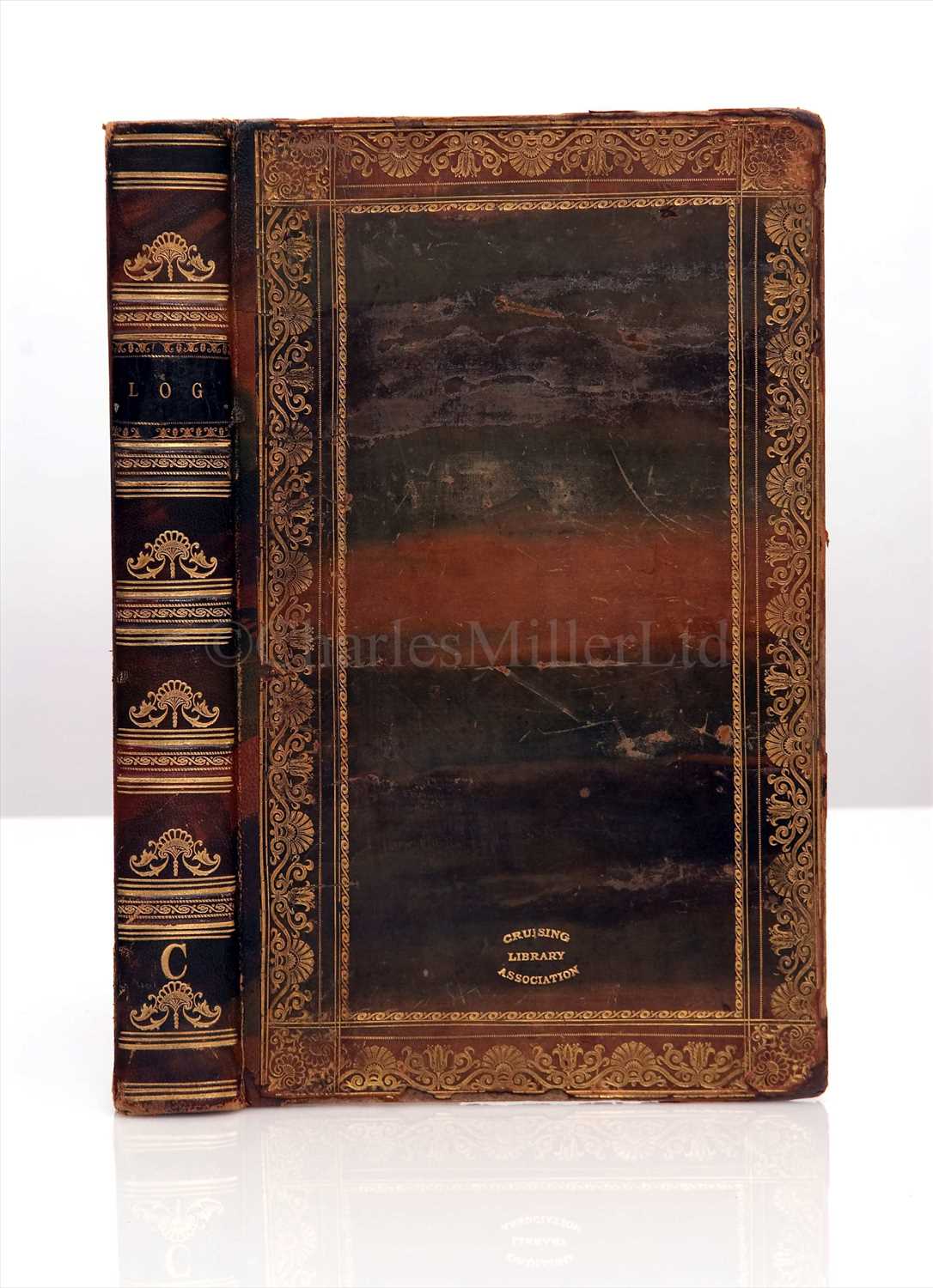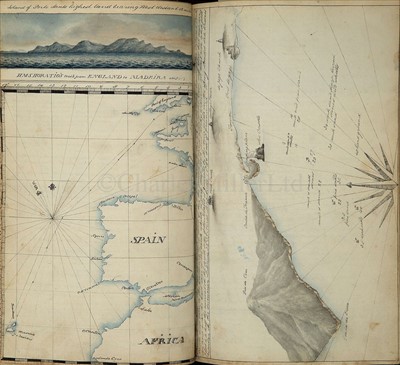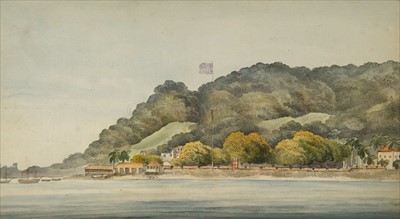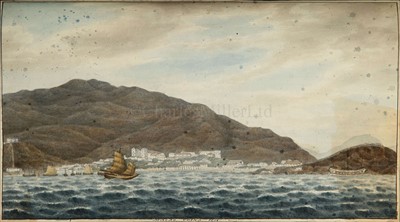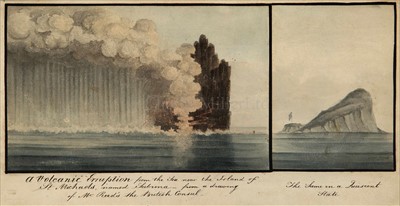21st Oct, 2009 12:00
Maritime and Scientific Models, Instruments & Art (Victory)
98
[M] A RARE AND EXCEPTIONAL EARLY 19TH-CENTURY...
A RARE AND EXCEPTIONAL EARLY 19TH-CENTURY MIDSHIPMAN'S LOG BOOK
entitled Log of the Proceedings of His Majesty's Ship HORATIO, W.H. Dillon. Esqr Capt. John Smith Gould MID, written in a clear hand between August 12th 1814 and January 10th 1816 and containing thirty-three full page titled watercolour illustrations and maps of exceptional quality and detail, consisting of many interesting early views including a volcanic eruption (before and during), icebergs ("ice islands"), 'Town of Funchal', 'Madeira', 'Ascension Islands', 'Macao', 'Anson's Bay', 'Singapore Straights', 'Malacca', 'Cape of Good Hope', 'St. Helena' (from south and north), 'Rio Janeiro' (Sugar Loaf hill and Town), 'a watering place east of Java', 'Madras' and 'Manilla', together with numerous watercolour vignettes, small map details, pen and ink sketches and diagrams of how the stores are arranged and stowed, bound between full calf decorated boards - 13 x 8½in. (33 x 21.5cm.)
H.M.S. Horatio was one of the fifteen 'Lively' class fifth rates designed by Sir William Rule and widely considered the finest British frigates spawned by the French Wars. Built by George Parsons at Burlesdon, Southampton, Horatio was measured at 1,089 tons and was 154 feet in length with a 40 foot beam. With a main armament of 28-18pdrs. on her upper deck, she also carried 4-9pdrs. and 14-32pdr. carronades which, in total, gave her impressive firepower for a vessel of her size. Launched on 23rd April 1807, she was first commissioned under Captain George Scott in June the same year, sailing for the North American Station that September. After seeing action in both the West and East Indies, and then off the Norwegian coast, she returned home in 1812 until despatched briefly to North America again in June 1814 under Captain William Dillon.
Soon recalled to the Channel Isles - where Dillon was appointed Senior Officer at Guernsey - Horatio was nearly lost when she struck an underwater rock in the Little Russell Passage, between Guernsey and Herm, whilst en route to keep watch off Cherbourg. The impact knocked 25 feet off her main-keel and she was only saved from sinking by "the most extraordinary exertions" of her captain and crew who somehow coaxed her into Portsmouth for repair. Back at sea, she returned to station off Cherbourg as the Admiralty initially believed that Napoleon would attempt to escape from there after his defeat at Waterloo. Afterwards voyaging to both China and India, Horatio was ordered home in 1816 and paid off the next year. Laid up for many years, she was finally converted to screw power in 1850 and, after employment in various roles, was sold for scrapping in 1865.
entitled Log of the Proceedings of His Majesty's Ship HORATIO, W.H. Dillon. Esqr Capt. John Smith Gould MID, written in a clear hand between August 12th 1814 and January 10th 1816 and containing thirty-three full page titled watercolour illustrations and maps of exceptional quality and detail, consisting of many interesting early views including a volcanic eruption (before and during), icebergs ("ice islands"), 'Town of Funchal', 'Madeira', 'Ascension Islands', 'Macao', 'Anson's Bay', 'Singapore Straights', 'Malacca', 'Cape of Good Hope', 'St. Helena' (from south and north), 'Rio Janeiro' (Sugar Loaf hill and Town), 'a watering place east of Java', 'Madras' and 'Manilla', together with numerous watercolour vignettes, small map details, pen and ink sketches and diagrams of how the stores are arranged and stowed, bound between full calf decorated boards - 13 x 8½in. (33 x 21.5cm.)
H.M.S. Horatio was one of the fifteen 'Lively' class fifth rates designed by Sir William Rule and widely considered the finest British frigates spawned by the French Wars. Built by George Parsons at Burlesdon, Southampton, Horatio was measured at 1,089 tons and was 154 feet in length with a 40 foot beam. With a main armament of 28-18pdrs. on her upper deck, she also carried 4-9pdrs. and 14-32pdr. carronades which, in total, gave her impressive firepower for a vessel of her size. Launched on 23rd April 1807, she was first commissioned under Captain George Scott in June the same year, sailing for the North American Station that September. After seeing action in both the West and East Indies, and then off the Norwegian coast, she returned home in 1812 until despatched briefly to North America again in June 1814 under Captain William Dillon.
Soon recalled to the Channel Isles - where Dillon was appointed Senior Officer at Guernsey - Horatio was nearly lost when she struck an underwater rock in the Little Russell Passage, between Guernsey and Herm, whilst en route to keep watch off Cherbourg. The impact knocked 25 feet off her main-keel and she was only saved from sinking by "the most extraordinary exertions" of her captain and crew who somehow coaxed her into Portsmouth for repair. Back at sea, she returned to station off Cherbourg as the Admiralty initially believed that Napoleon would attempt to escape from there after his defeat at Waterloo. Afterwards voyaging to both China and India, Horatio was ordered home in 1816 and paid off the next year. Laid up for many years, she was finally converted to screw power in 1850 and, after employment in various roles, was sold for scrapping in 1865.
Sold for £49,600
Estimated at £4,000 - £6,000
(inc. buyer's premium of 24%)
A RARE AND EXCEPTIONAL EARLY 19TH-CENTURY MIDSHIPMAN'S LOG BOOK
entitled Log of the Proceedings of His Majesty's Ship HORATIO, W.H. Dillon. Esqr Capt. John Smith Gould MID, written in a clear hand between August 12th 1814 and January 10th 1816 and containing thirty-three full page titled watercolour illustrations and maps of exceptional quality and detail, consisting of many interesting early views including a volcanic eruption (before and during), icebergs ("ice islands"), 'Town of Funchal', 'Madeira', 'Ascension Islands', 'Macao', 'Anson's Bay', 'Singapore Straights', 'Malacca', 'Cape of Good Hope', 'St. Helena' (from south and north), 'Rio Janeiro' (Sugar Loaf hill and Town), 'a watering place east of Java', 'Madras' and 'Manilla', together with numerous watercolour vignettes, small map details, pen and ink sketches and diagrams of how the stores are arranged and stowed, bound between full calf decorated boards - 13 x 8½in. (33 x 21.5cm.)
H.M.S. Horatio was one of the fifteen 'Lively' class fifth rates designed by Sir William Rule and widely considered the finest British frigates spawned by the French Wars. Built by George Parsons at Burlesdon, Southampton, Horatio was measured at 1,089 tons and was 154 feet in length with a 40 foot beam. With a main armament of 28-18pdrs. on her upper deck, she also carried 4-9pdrs. and 14-32pdr. carronades which, in total, gave her impressive firepower for a vessel of her size. Launched on 23rd April 1807, she was first commissioned under Captain George Scott in June the same year, sailing for the North American Station that September. After seeing action in both the West and East Indies, and then off the Norwegian coast, she returned home in 1812 until despatched briefly to North America again in June 1814 under Captain William Dillon.
Soon recalled to the Channel Isles - where Dillon was appointed Senior Officer at Guernsey - Horatio was nearly lost when she struck an underwater rock in the Little Russell Passage, between Guernsey and Herm, whilst en route to keep watch off Cherbourg. The impact knocked 25 feet off her main-keel and she was only saved from sinking by "the most extraordinary exertions" of her captain and crew who somehow coaxed her into Portsmouth for repair. Back at sea, she returned to station off Cherbourg as the Admiralty initially believed that Napoleon would attempt to escape from there after his defeat at Waterloo. Afterwards voyaging to both China and India, Horatio was ordered home in 1816 and paid off the next year. Laid up for many years, she was finally converted to screw power in 1850 and, after employment in various roles, was sold for scrapping in 1865.
entitled Log of the Proceedings of His Majesty's Ship HORATIO, W.H. Dillon. Esqr Capt. John Smith Gould MID, written in a clear hand between August 12th 1814 and January 10th 1816 and containing thirty-three full page titled watercolour illustrations and maps of exceptional quality and detail, consisting of many interesting early views including a volcanic eruption (before and during), icebergs ("ice islands"), 'Town of Funchal', 'Madeira', 'Ascension Islands', 'Macao', 'Anson's Bay', 'Singapore Straights', 'Malacca', 'Cape of Good Hope', 'St. Helena' (from south and north), 'Rio Janeiro' (Sugar Loaf hill and Town), 'a watering place east of Java', 'Madras' and 'Manilla', together with numerous watercolour vignettes, small map details, pen and ink sketches and diagrams of how the stores are arranged and stowed, bound between full calf decorated boards - 13 x 8½in. (33 x 21.5cm.)
H.M.S. Horatio was one of the fifteen 'Lively' class fifth rates designed by Sir William Rule and widely considered the finest British frigates spawned by the French Wars. Built by George Parsons at Burlesdon, Southampton, Horatio was measured at 1,089 tons and was 154 feet in length with a 40 foot beam. With a main armament of 28-18pdrs. on her upper deck, she also carried 4-9pdrs. and 14-32pdr. carronades which, in total, gave her impressive firepower for a vessel of her size. Launched on 23rd April 1807, she was first commissioned under Captain George Scott in June the same year, sailing for the North American Station that September. After seeing action in both the West and East Indies, and then off the Norwegian coast, she returned home in 1812 until despatched briefly to North America again in June 1814 under Captain William Dillon.
Soon recalled to the Channel Isles - where Dillon was appointed Senior Officer at Guernsey - Horatio was nearly lost when she struck an underwater rock in the Little Russell Passage, between Guernsey and Herm, whilst en route to keep watch off Cherbourg. The impact knocked 25 feet off her main-keel and she was only saved from sinking by "the most extraordinary exertions" of her captain and crew who somehow coaxed her into Portsmouth for repair. Back at sea, she returned to station off Cherbourg as the Admiralty initially believed that Napoleon would attempt to escape from there after his defeat at Waterloo. Afterwards voyaging to both China and India, Horatio was ordered home in 1816 and paid off the next year. Laid up for many years, she was finally converted to screw power in 1850 and, after employment in various roles, was sold for scrapping in 1865.
Auction: Maritime and Scientific Models, Instruments & Art (Victory), 21st Oct, 2009
